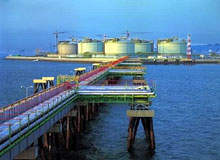
The Korea Gas Corporation (KOGAS) completed their LNG terminal in Incheon, South Korea in mid-2002. The Incheon LNG terminal is one of the biggest in the world and began its operation with three storage tanks (each 100,000m³) and 360t/hour of regasification capacity in 1996.
In order to meet increased LNG demand, the terminal has been continuously expanded ever since. The terminal now operates 22 sets of LNG storage tanks – ten above-ground full containment tanks and 12 in-ground tanks – with a total storage capacity of three million cubic metres. Two of the 12 in-ground tanks, with a capacity of 200,000m³, were constructed by Hyundai Engineering Company (HEC) as part of a further round of expansion. They were opened in June 2009.
Currently, the terminal has a 3,870t/hour regasification capacity. It was able to provide the Seoul metropolitan area with 14 million tonnes per annum (Mtpa) of natural gas by 2004.
HEC is providing engineering, procurement services, construction supervision and project management services for this project.
Technical challenges
The facility has had its share of technical challenges including: optimisation of vaporisation with low seawater temperature in winter, operation of two different types of storage tanks (underground and above ground), dynamic operation of a double berth system, safe tie-in under operation conditions and future expansion plans.
Construction
Samsung and Daewoo played a large part in the first stage of construction as they were awarded the #13 and #14 underground storage and gasification elements and overground storage tanks contracts.
The LNG storage tank project involved the procurement of such elements as: all the tank internal piping including pump column, LNG stand pipe, spray ring, level instrument and LTD system stilling well and N2 purge system, cryogenic control valves, nozzles, manholes, instrument air piping, piping insulation, a fire fighting system and the safety valve system. The construction began in November 1998.
Storage tanks
Samsung was the lead contractor responsible for EPC in storage tanks and the overall system. It provided engineering, procurement and site construction services such as pilings, slurry concrete walls, steel structure, equipment, piping, electrical and instrument cabling, painting, insulation and more. Specialized construction included concrete outer and steel membrane type inner storage units, gasification, pumps and other equipment.
The underground storage was constructed with a slurry concrete wall and a concrete tank wall with inner thin stainless steel membrane plates. The gasification was made with saline water. Additional facilities include pumping and compressing as well as flare stack.
Valves at the LNG terminal
Cryogenic valves for the Inchon LNG terminal expansion were supplied by Severn Glocan, a UK company. The valves, which will be used at temperatures of less than –160°C, are all equipped with Severn Glocon pneumatic piston actuators, explosion proof positioners, manual override handwheels and in some cases, anti-cavitation trims.
Before being shipped to the Far East, the valves will be tested at the company facilities in Gloucestershire. The British company has been a supplier to the Korean Gas Company for some years.
Extension of above-ground LNG storage tank
Daewoo and Daetim have built three 100,000m³ capacity above-ground LNG storage tanks (#4, #5 and #6), including pipework, electrics and instrumentation and civil works.
The inner tank diameter is 68m, the outer tank diameter is 70m and the height is 36m. It has a concrete dome roof with steel plate and suspended deck and pre-stressed concrete walls. The tank also has a primary membrane of stainless steel with 9% nickel. The maximum liquid level is 29.94m.
Phase two extension above-ground LNG storage tank
The second storage tank (#15, #16, #17 and #18) to be built by Daewoo has an inner tank diameter of 72m, and an outer diameter of 78.6m. The height of the tank is 53.6m, and the maximum liquid level is 49.2m. Its capacity is 200,000m³. The tank uses a stainless steel membrane, a slab for a strong bottom, and a concrete dome with steel underneath for the roof.
The storage tanks are designed so that they can contain the LNG with the steel structure alone, even if the concrete were removed. If the steel tank inside leaks there is an outer tank to contain the damage. Between the two tanks is an insulation layer. The steel roof was designed using FEM (Finite Element Method) analysis.

